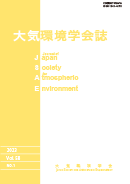
- Issue 6 Pages 87-
- Issue 5 Pages A135-
- Issue 4 Pages A101-
- Issue 3 Pages 67-
- Issue 2 Pages 47-
- Issue 1 Pages 1-
- |<
- <
- 1
- >
- >|
-
Kyo Kitayama, Satoru Chatani2023Volume 58Issue 6 Pages 87-98
Published: October 13, 2023
Released on J-STAGE: October 13, 2023
JOURNAL FREE ACCESSActivities related to pollutant emissions were applied to multiple regressions and seasonal decomposition for extracting hourly and monthly emission variations used for atmospheric models. The results of the analyses were used for evaluating emission changes during the COVID-19 pandemic. The activities used for the analyses were thermal powers, energy consumption of stationary sources, and travel distance of motor vehicles. Hourly variations were high from 9 to 18. Weekly variations were high from Tuesday to Friday. Monthly variations were low in May and October, May and June, and February for thermal powers, energy consumption, and travel distance, respectively, and high in December and January. Reductions during the COVID-19 pandemic were evaluated by activity differences between 2019 and 2020. Annual relative differences were −1.5, −10, and −8.0% for the thermal powers, energy consumption, and travel distance, respectively. Those in a state of emergency months, i.e., April and May, were −9.0, −13, and −18%, respectively. The annual relative differences in the spatial means of the NOx and PM2.5 concentrations on the ground were −6.8 and −7.5%, respectively. Those in April and May were −13 and −11%, respectively. Reductions of the activities during the COVID-19 pandemic were comparable to those of the related chemical measurements.
View full abstractDownload PDF (3513K) -
Shoichi Sakamoto, Kimiyo Kumagai, Hiroshi Tago2023Volume 58Issue 6 Pages 99-108
Published: November 07, 2023
Released on J-STAGE: November 07, 2023
JOURNAL FREE ACCESSA daytime highly time-resolved volatile organic compounds (VOCs) survey was conducted in Maebashi, Gunma Prefecture during the high photochemical oxidant concentration episode in the Kanto region in June 2022. During the daytime when the solar radiation increased, the concentrations of alkanes and aromatics decreased and the concentration of aldehydes increased. This was considered to be the result of the consumption of alkanes and aromatics and the formation of aldehydes by photochemical reactions. However, on days when the northwest wind was blowing during the daytime, the daytime Ox concentration did not significantly increase and the concentrations of the alkanes and aromatics from anthropogenic emissions were relatively low. In the evening when the southeasterly wind was blowing, the Ox concentration was the highest and simultaneously, the concentrations of alkanes, aromatics, and aldehydes increased. This result was attributed to the arrival of Ox generated by photochemical reactions during advection processes in the air masses containing high concentrations of anthropogenic VOCs emitted in the southern Kanto region, and the VOCs that remained unconsumed. In order to reduce the high concentration of Ox in the inland Kanto region, it is important to consider countermeasures of VOCs over the wide area of the Kanto region.
View full abstractDownload PDF (2432K)
-
Shinji Wakamatsu2023Volume 58Issue 6 Pages A153-A181
Published: November 10, 2023
Released on J-STAGE: November 10, 2023
JOURNAL RESTRICTED ACCESSDownload PDF (16560K)
- |<
- <
- 1
- >
- >|